The sensational fluffy cow breed is more than just a picturesque and cuddly giant cow that most—if not all—of us would like to keep as a pet. It is a breed of cows known as the Highland that is native to the Scottish Highlands.
And while they may look more appealing alive, Highland cattle are bred for their meat—as is the case with other cattle breeds.
Read on to better understand these striking creatures and everything it takes to give them the fluff that is easy to love and adore.
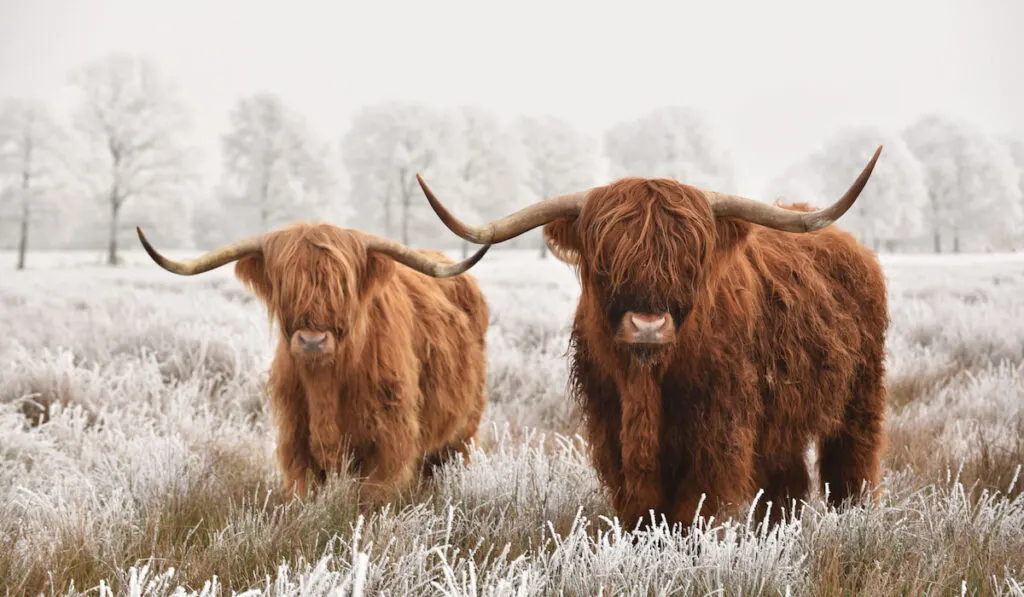
Table of Contents
History
Though the fluffy cow breed has only gained popularity in recent years, you’ll be surprised to know that the breed has been around for hundreds of years.
The Highland cow might even be among the oldest cattle breeds in the world, appearing in written records from the 6th century.
Highland cows get their name from their origin: the Scottish Highlands and islands. This led to the formation of the Highland Cattle Society in 1884, with the first herd being recorded a year later.
Originally, the breed was classified as either Highlander or West Highlands (also known as Kyloe). The Kyloes were predominantly smaller with black and brownish-orange or yellowish-brown coats. Highlanders, on the other hand, were larger, with grayish-brown coats.
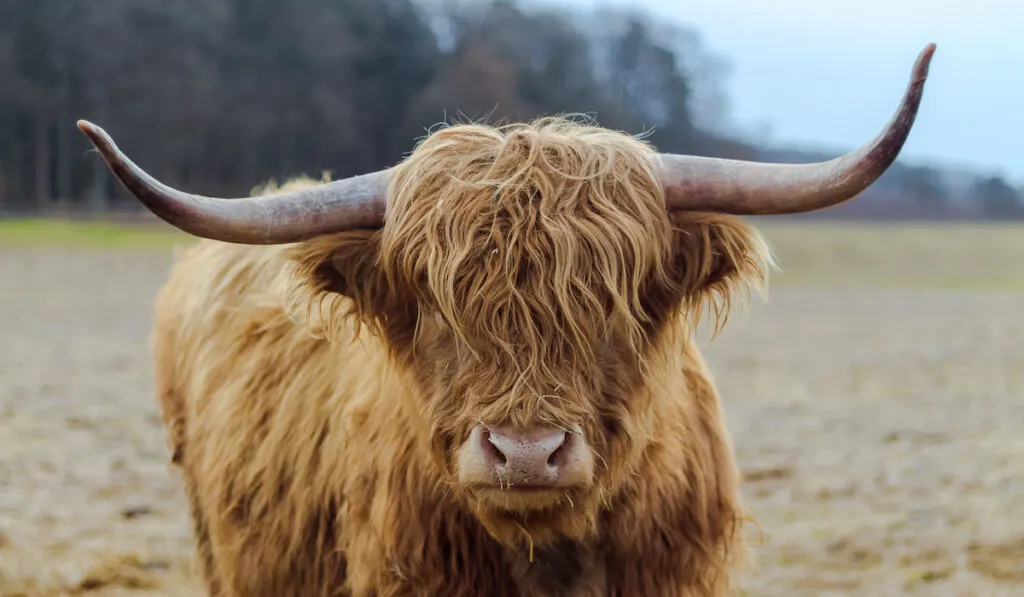
Attributes
The most memorable characteristics of these photogenic creatures are their long horns and bangs. Besides its aesthetic appeal, there is a good chance that the cattle’s long fringe plays a role in keeping flies away from the eyes.
Another characteristic feature of the Highland cows is their unique coat, hence the name “fluffy cow.”
Highland cows are adapted to the nature of the environment they thrive in. They have a downy undercoat and a longer, oily outer coat that can grow up to 13 inches long to easily expel snow and rainwater.
While this double coat is classically associated with a brownish color, Highland cows can also present as black, dun, yellowish, white, silver, or even red.
The double coat is groomed with specific oils and conditioners to achieve a picture-perfect fluffy look during a showing.
As part of their adaptation, fluffy cows start shedding their thick coat in the cooler months of spring and grow considerably less hair throughout summer.
The long, thick coat then regrows during the colder months. This shows that the Highland cow’s fluffy coat is not their permanent state of being.
Another feature you can’t miss at a glance are the exotic horns that endow the magnificent heads of this cattle breed. Contrary to what you may think, there is a distinct difference between the appearance of the horns in bulls and cows.
A cow’s horns are slender and longer and curve upwards, whereas a bull’s horns are thicker with a wide base and curve forwards with a slight rise towards the tips.
Other Highland characteristics include the following:
| Life span | 18–22 years |
| Height | 3-4 ft (90–120 cm) |
| Weight | 1,102-1,763 lbs (500-800 kg) |
| Origin | Scotland |
| Birth weight | 50-70 lbs (23–32 kg) |
| Average productive life | 12 calves per cow typically |
| Reproductive behavior | Polygamous |
| Gestation period | 9 months |
| Number of calves | 1 per pregnancy |
| Distribution | North America, South America, Europe, South Scotland, Australia |
Diet

Due to their lightweight nature, Highland cows make exceptional conservational grazers. This hardy cattle breed can survive on brush and fodder as long as they have access to fresh water.
For instance, Highland cattle can use their horns to dig through snow to access vegetation during winter.
However, owners also use silage, straw, or hay during the winter months or other customized diets suitable for their fold. These customized diets may include the following:
- Turnips
- Cereal grains
- Barley
- Corn silage
- Hay
- Grass
- Wheat
- Peas
All in all, this cattle breed will feed on anything hebaceous, including tree leaves as high as they can reach. As with other cattle breeds, owners might also use special supplements for nursing and pregnant cows.
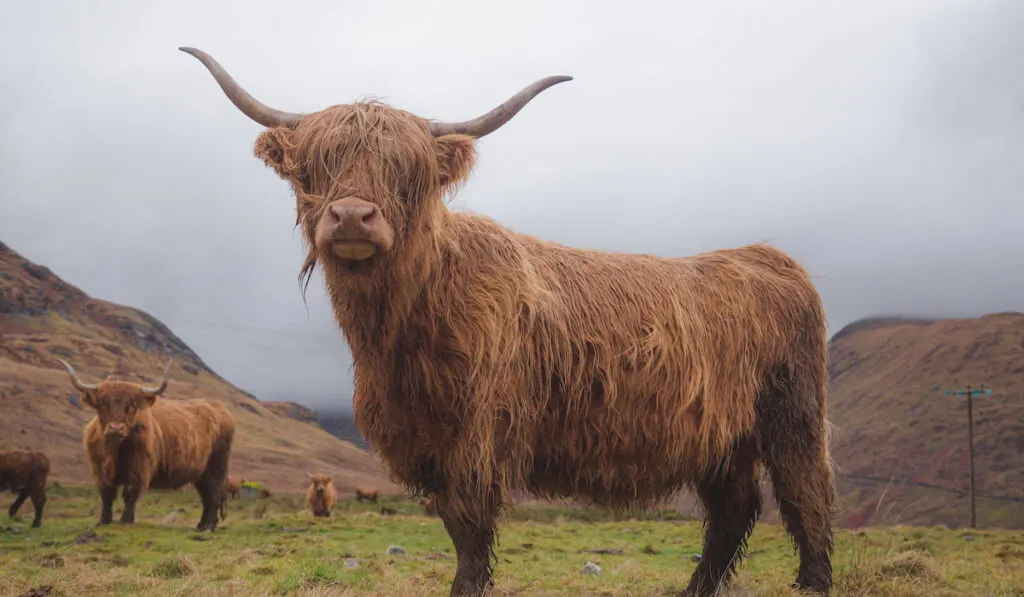
Growth and Production
Contrary to what you may think, fluffy cows are mainly bred for their high-quality beef.
Due to their double-layered coat that helps maintain warmth during various seasons of the year, Highland cows do not have a thick layer of fat like other cattle breeds.
This way, this cattle breed can produce lean but well-marbled beef that is rich in flavor and protein but low in cholesterol—comparable to fish and chicken as far as fat content goes.
As such, Highland cattle beef commands a premium price tag.
In addition to high-quality beef, Highland cows also produce milk. While it may not be as much as a dairy cow would produce, it’s enough for personal use and nourishing their calves.
As with beef, Highland cow milk is of high quality and can contain up to 10% butterfat content.
This explains why fluffy cow calves grow rapidly after birth.
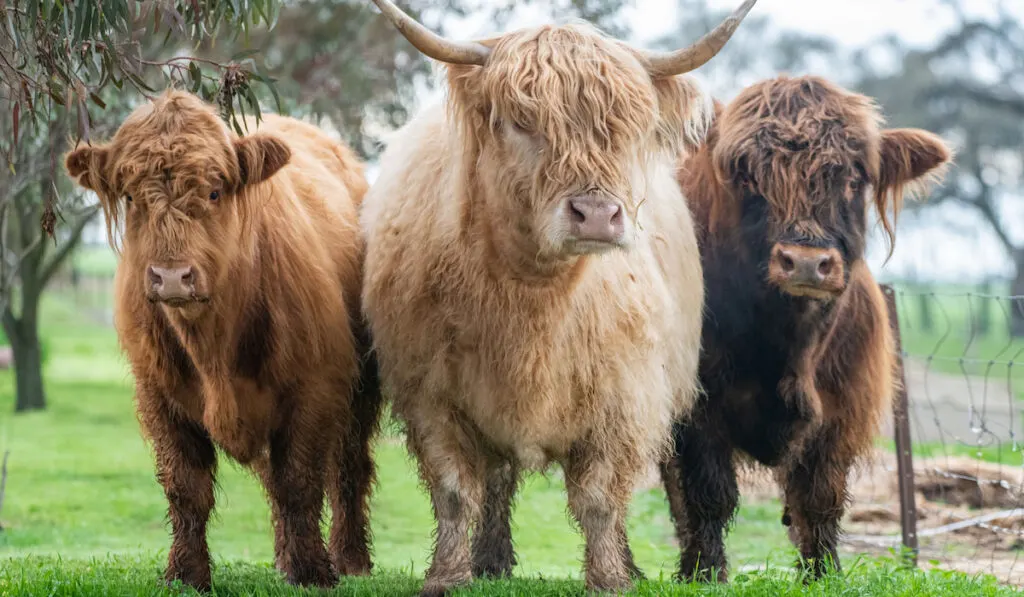
Crossbreeding
Today, crossbreeding of the Highlands is primarily due to the declining market for high-quality meat. That said, crossbreeding Highlands with other cattle breeds dates back to the early 20th century when the breed began being exported worldwide.
Crossbreeding is partly what has led to the loss of the unique difference between the original two breed divisions.
To address the rising popularity of low-cost meat options, owners are breeding Highland cows with bulls of other breeds like the Limousin and Shorthorn. This results in high-quality beef with a competitive market value.
The crossbred cows also inherit the innate features of their Highland mothers.
What’s more, Highland cows often breed past the age of 18 and can raise 15 or more calves throughout their lifespan.
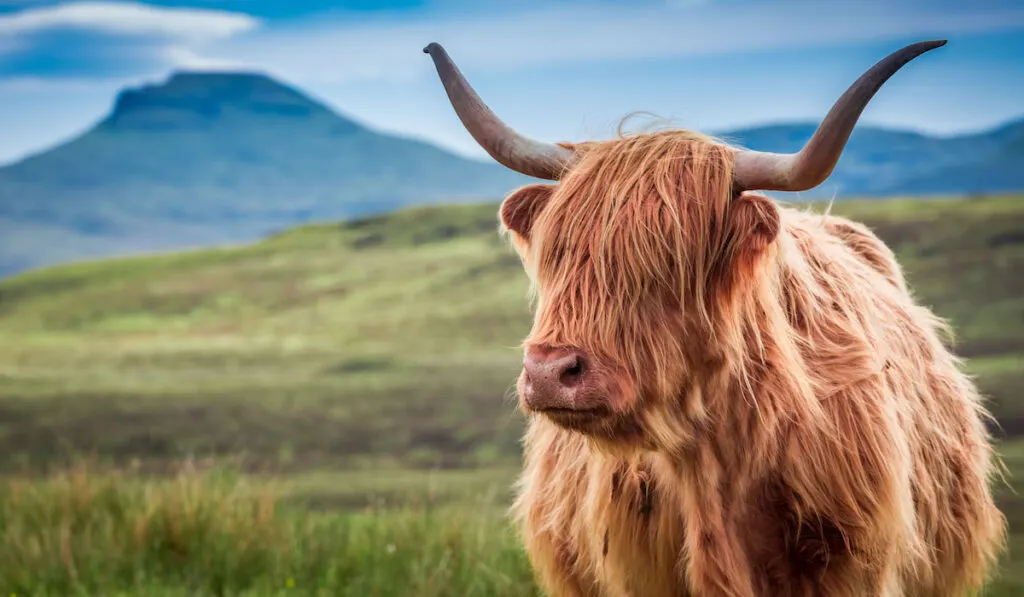
Showing
Aside from showcasing the fluffy coats of their Highland calves, showing is how cattle owners get to flaunt the exotic genetics in their folds.
For such events, the cattle are usually groomed with special conditioners and oils to fluff and add glimmer to their coats.
While this is how the fluffy cow thrill came to life on the internet, showing is primarily for official purposes, like displaying cattle for sale or for genetic showcasing.
The Highland Cattle Society stipulates breed grade guidelines to ensure that breeders produce the highest standard cattle.
This includes the criteria for judging the cattle based on the following:
- The Head: The dossan should be long and wavy, with full, bright eyes .
- Horns: When well set, the horns should give the cattle a mark of superiority to command attention.
- Neck and shoulders: The neck shouldn’t have a dewlap and must be linearly aligned to the thick shoulders in cows but should have a crest in bulls.
- Body, back, and hind: The back should be straight, and the animal should move with poise.
- Long and wavy hair: The hair should be long and wavy as opposed to being curly.
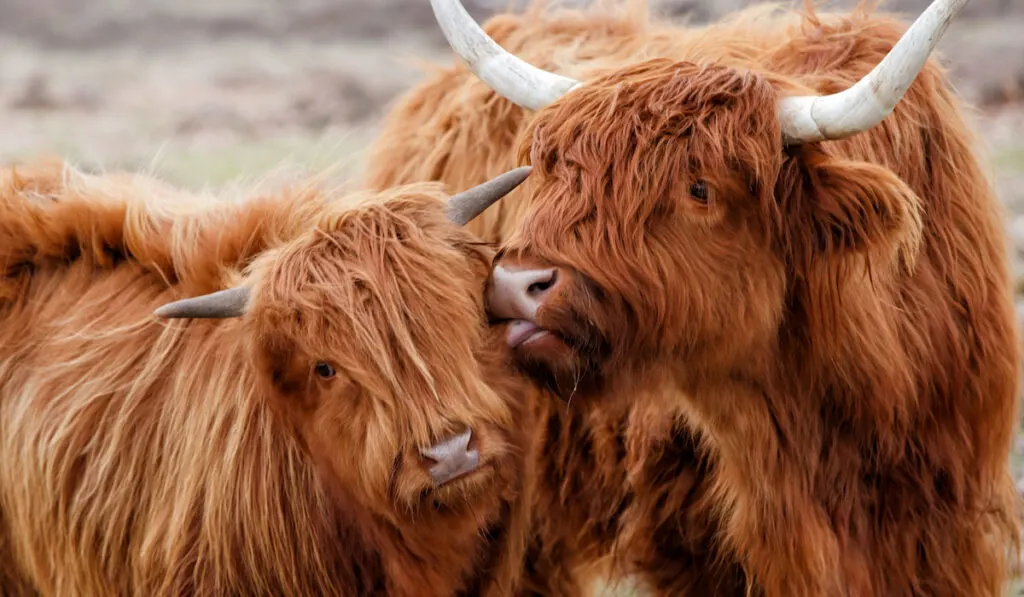
Temperament
As you may expect, Highland cows are gentle beasts that are friendly, submissive, and barely show aggression. This is thanks to their high intelligence and understanding of their social hierarchy and their place in it.
It is, therefore, natural for them to be around people and seek attention and affection, while satisfying their curiosity. Their friendliness also makes Highland cows easy to breed and care for.
However, exercise caution whenever you are around folds with calves as the cows can be protective.
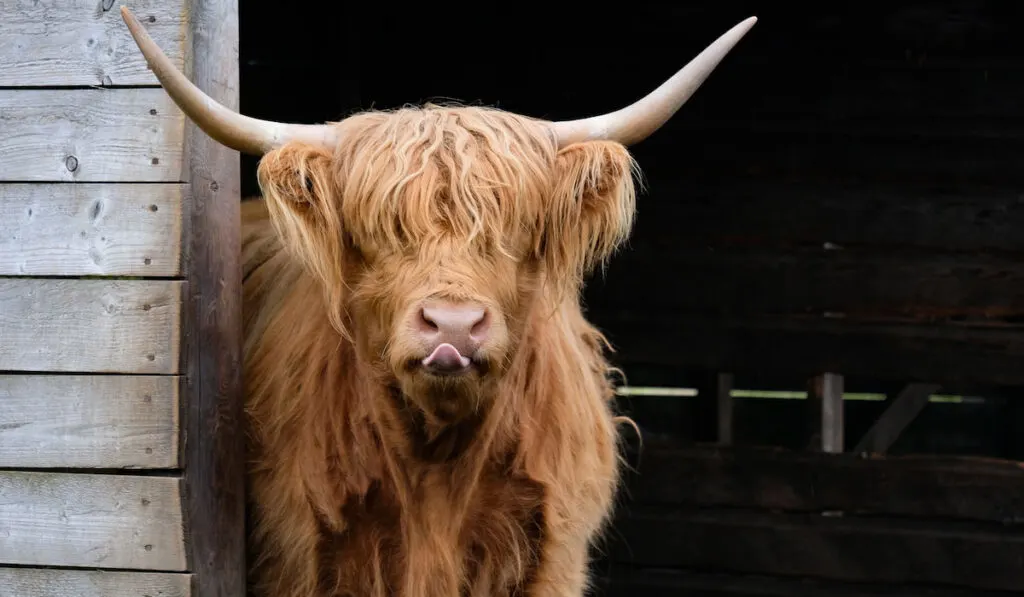
Fun Facts
Here are some additional fun facts about the fluffy cow breed you might not know about:
- The long-fringe on Highland cows is also called the dossan.
- While a group of cattle is commonly known as a herd, a group of Highland cattle is referred to as a fold.
- The selective breeding that initiated the decline of the Kyloe breed is rumored to have been a result of the queen’s preference for the redder Highlander breed.
- Highland cows prefer foraging to feeding in barns.
- Locals within Scotland refer to the Highland cattle as “Hairy Coos.”
- Highland cattle graze for up to 8 hours a day and can consume up to 154 lbs (70kg) of forage.
- It is believed that the only beef Queen Elizabeth ate was from her Highland cattle fold.
Final Thoughts
There you have it. As you can now see, there is more to the fluffy cow breed than their elegantly groomed hair. Being a robust breed that is easy to breed and raise, Highland cows offer more than what we see at face value.
Thanks to this new knowledge, we hope you will now look at the fluffy cows differently and appreciate the care and work that goes into turning them into the hairy coo we adore.
Resources
- https://www.highlandtitles.com/blog/highland-cows/
- https://www.highlandcattlesociety.com/breed-standards
- https://www.outdoorhappens.com/ultimate-guide-mini-highland-cow/
- https://theculturetrip.com/europe/united-kingdom/scotland/articles/6-things-you-need-to-know-about-the-highland-cow/
- https://animalia.bio/highland-cattle#domestication
- https://www.thecattlesite.com/breeds/beef/40/highland/
